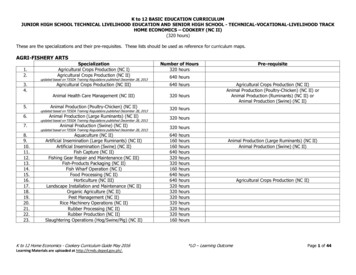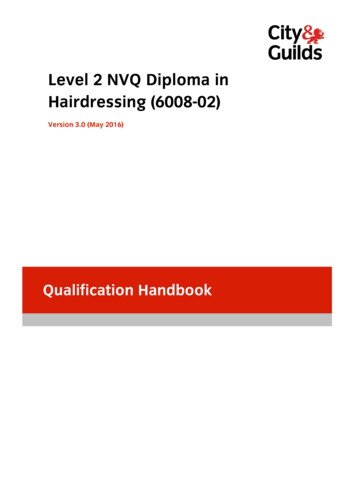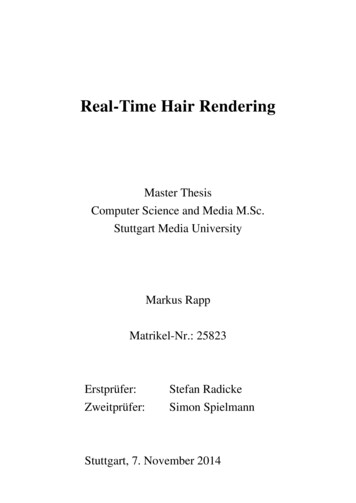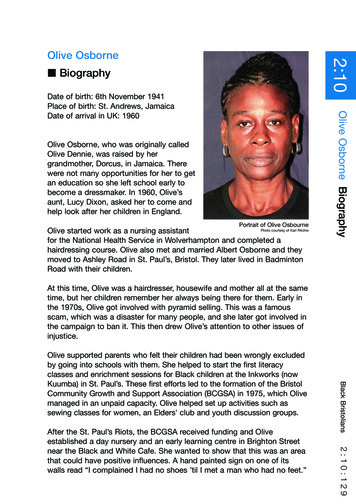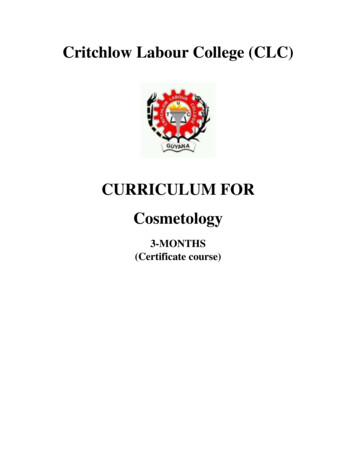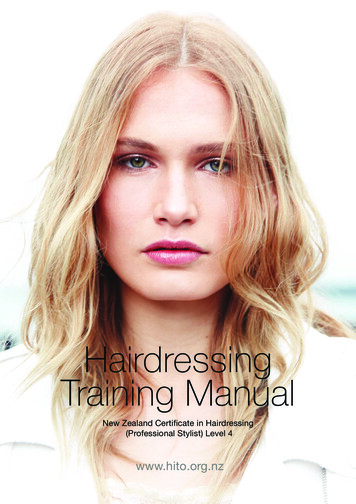
Transcription
HairdressingTraining ManualNew Zealand Certificate in Hairdressing(Professional Stylist) Level 4www.hito.org.nz
Copyright 2016 New Zealand Hair and Beauty Industry Training Organisation
IntroductionIntroductionWelcome2Training expectations3Training resources4Training tips5Assessment8Learning9Workplace behaviour guidelines11The HITO team12Training Requirements15Unit Standard GuidesYear one23Year two85Year three137Year four1751
IntroductionWelcomeCongratulations on taking on a HITO hairdressing apprentice.This is your training manual. It contains general training advice and specific activities to help yourapprentice learn.The hairdressing qualification is made up of unit standards which cover the skills your apprentice needsto know. The manual goes through each unit standard, starting with the easiest ones and working up toharder ones. You should work through the units in the order they appear in the training manual.You’ll also notice that the unit standards in this book are divided by year level. It should take no more than12 months to complete the units in each year. Your apprentice must complete all the units in a year levelbefore moving onto the next year level.There is a glossary at the back to explain any words your apprentice doesn’t understand.This manual contains advice on training in general, how HITO training works, and who to ask for help ifyou need it. This information is in the Introduction section.Keep this manual at the salon at all times. You’ll need to refer to it often when training, and your HITOSales and Liaison Manager may need to see it when they visit.Hairdressing apprentices also receive a Training Record Book, which lists all the unit standards in thequalification and the skills involved. The Training Manual and the Training Record Book are used togetherin training.Throughout the manual you’ll see references to some textbooks. You’ll need to purchase these textbooksor visit your local library to see if they have them.A salon only needs one copy of this manual for all their apprentices. This manual is for the New ZealandCertificate in Hairdressing (Professional Stylist) Level 4.2
IntroductionTraining expectationsAn apprentice does most of their training in the workplace, where they work through the trainingresources with the help of their trainer. Trainers need to hold the Hairdressing (Professional Stylist) Level 4qualification or equivalent.An effective trainer: provides a safe and supportive workplace. integrates learning tasks into work activities based on a plan. acts as a role model. meets with HITO and their apprentice regularly to make sure that the training is working and to reviewprogress using the training plan. manages their apprentice’s training needs and motivation. helps their apprentice develop problem-solving and general employment skills. provides regular feedback and encouragement. promotes independence and self-direction in learning. maintains records of progress. clearly sets out the relationship between trainer and apprentice.The trainer is also responsible for: liaising with the HITO Sales and Liaison Manager about training. monitoring the apprentice’s progress. giving clear instructions and guiding their apprentice. giving constructive feedback. keeping track of the progress in the Training Record Book and following the Training Plan created withthe help of the HITO Sales and Liaison Manager. helping their apprentice engage in training. supervising the apprentice while they learn each new task. Once they understand the task properly, andthey have the required number of signatures in their Training Record Book, they don’t need supervisionanymore. The longer your apprentice trains for, the more tasks they can complete on their own.Training doesn’t always go perfectly, so if you have any issues: Remain calm and provide open and honest feedback to the learner. Keep their age and inexperience in mind, and give them a second chance. Intervene as early as possible to get a problem solved. Respect their employment and personal rights. Treat learners with respect and dignity. Apprentices have feelings too. Remember that HITO is here to help.An apprentice is a real asset to any business. Like any other staff member, if you put in the effort to trainand support them, they’ll become a valuable member of your team.3
IntroductionTraining resourcesTraining Record BookEvery apprentice receives a Training Record Book.The Training Record Book contains the details of every unit standard an apprentice has to completeto gain their qualification. This book contains the details of every unit standard and the skills needed tocomplete the qualification.The Training Record Book helps employers and apprentices keep track of the apprentice’s training.Each page explains what the unit standard is about, and some come with extra activities to help theapprentice learn each skill.The apprentice has to complete each skill under the supervision of a qualified trainer. Each time theapprentice completes a task successfully, the trainer signs the training record book. Once all the signatureboxes are full, the apprentice is ready for assessment. HITO will organise the assessments.Only a qualified trainer can sign the Training Record Book. Anyone who is qualified and intendsto supervise the apprentice needs to sign the Specimen Signatures page at the front of the book.Our HITO Sales and Liaison Managers (SLMs) visit apprentices throughout the year. Every time theyvisit the SLM will review the Training Record Book to make sure the apprentice is progressing throughtheir training.Once the apprentice achieves every unit in their Training Record Book, they will be fully qualified.VUEVUE is an online learning resource with videos, descriptions, and quizzes to help learners succeed.The videos on VUE demonstrate the exact industry standard that learners need to achieve. The morepeople who access VUE, the more certain we can be that our whole industry is performing to a highstandard.VUE is also an online portfolio. Learners can create photographic portfolios online and share theseportfolios on social media or with their assessors.Employers and apprentices can access VUE via the internet, Android or Apple device. When the learnersigns-on with HITO, we send the learner and employer a login.If you need to contact us about VUE, email vue@hito.org.nz4
IntroductionTraining tipsApprentices need a workplace where learning is encouraged through high-quality training and support.There are several factors that positively influence learning in the workplace: A clear learning culture that acknowledges the importance of training. Structured training and tracking of trainee progress. Regular time devoted to training. Incentives to learn. Support for trainees.Develop a formal training planA formal training plan boosts training success. Each business will have different training needs, so think aboutwhat will best suit both your business and your learner. There are several things each plan should include: Dedicated time for training. This might be one morning per week, or on Monday’s when you’re closed. A description of the skills your learner needs to learn and when they need to learn them by.If they are on track with their Training Plan, then the plan is working. A list of the resources needed for training e.g. equipment, products, tools, and clients. Identify skilled staff who can support the learner while they train.Learning stylesBy getting to know your learner, you’ll figure out which style suits them best – visual, auditory, or kinesthetic.Refer to page 8 for more information on learning styles. You can then tailor their training to suit their learningstyle. You’ll also need to consider their personality, culture, and ethnicity. Work with them to train them in away that works for both of you.A learning cultureA learning culture in your workplace will help everyone learn and improve. Some ways to introduce orimprove your learning culture include: promoting strong communication and collaboration between team members. structuring your processes around helping employees learn. working with other groups e.g. customers to encourage their participation in helping your staff learn. giving your staff the opportunity to contribute to changes in the business.5
IntroductionCharacteristics of a business with effective training Clear training policies that identify the value of learning and learners. More satisfied clients and repeat business. Increased salon revenue. Good team work. Motivated and skilled staff. Enhanced staff morale. Higher staff retention rates.A positive working environmentRemember that the workplace trainer plays an important role in supporting and facilitating the learningculture of a workplace.The four stages of trainingStage 1 - InstructionHowWhenWhere Read through the UnitStandard in this manual andthe Training Record Book. Formal training sessions. In the apprentice’s own time. In the salon. It’s helpful to gothrough each skill before theapprentice attends off-jobtraining.HowWhenWhere Allow the apprentice topractice on mannequins. Formal training sessions. In the salon. Supervised work in the salon. At off-job training. Watch the relevant video onHITO VUE. Discuss what the apprenticehas viewed and read. Demonstrate the skill.Stage 2 - Practice Have the apprentice practiceon models during trainingsessions. Supervise the apprenticewhile they practice on clients.6
IntroductionStage 3 – Collection of evidenceHowWhenWhere Observe the apprentice whenthey complete a task. Formal training sessions. In the salon. Sign the Training RecordBook when they completethe task according to thestandard set out in this book,the Training Record Book,and on HITO VUE. In the apprentice’s own time.Stage 4 - AssessmentHowWhenWhere The apprentice will attendoff-job training at their localprovider. Off-job training. One day per week at the localtraining provider. The provider will check theTraining Record Book andeither deem the evidencesufficient or ask theapprentice to sit a furtherassessment: a demonstrationor answering questions. The apprentice may also learnsome of their skills and beassessed on them at off-jobtraining.Unsuccessful assessmentsIf your apprentice doesn’t pass an assessment, try the following: Discuss the assessment with the assessor and find out what the apprentice needs to do differently. Work with your apprentice to improve their skills and practice. Support and encourage your apprentice to try again.If you feel the assessor’s judgment was unfair, contact the off-job training provider. Let HITO know you aredoing this first.7
IntroductionAssessmentTheory assessments will be either a closed book theory test (like a small exam) or an assignment.During a theory test you cannot look at the answers, talk to your classmates or leave the room and thencome back in and continue with the test. You should use blue or black pen for assessments.Assignments are sometimes referred to as ‘open book’ assessments. These will be issued to you andyou will be given a due date. You can research or use a study guide for the information you need foryour assignment.Practical assessments for hairdressing skills are carried out at the training provider (polytech). You willcollect all your evidence in the salon then you will need to get a model and do your assessment whenyou are ready. The assessor will watch you perform tasks just as you would do them in the salon. Youcan do several assessments on one model, such as, shampoo, treatment and blow dry. Some trainingproviders have set days for set tasks while others allow you to book in for the assessments you are readyfor. This will be explained to you when you start at the training provider.Some assessments may be done in the salon with the trainer acting as the verifier. These assessmentshappen in the salon when it’s not practical to do them at a training provider. The trainer needs to completea verification form which the apprentice them takes to off-job training so their tutor can sign it off.Once you have successfully completed your assessments, your training provider will sign your TrainingRecord Book and register the unit for you.8
IntroductionLearningHow adults learnKnowing how people learn will help you train them. People learn best when they: know why they are learning something. are learning something that is relevant to them. can use what they are learning straight away. have opportunities to learn things themselves, including by trial and error. feel responsible for and involved in their learning. are motivated to learn.Remember, each learner will have a different level of knowledge and skill before they start. You need to beaware of what they already know and what they still need to learn. Resources like this training manual willhelp you figure this out.Learning stylesThere are three styles of learning: visual (seeing), auditory (hearing), and kinesthetic (hands-on). Peopleusually use a combination of all three learning styles, but you may find that your apprentices and traineesprefer one over the others.Visual learners: like to see things, including reading. will often ask you to show them. will often say “OK I see” or “Can we look at this bit?”Activities Show the apprentice or trainee the task, the equipment or a picture of the equipment as you talkabout it. Give apprentices/trainees handouts with pictures or diagrams to help them understand andremember. Get apprentices/trainees to write down, draw a diagram or write notes on a diagram of what youhave just shown them. Use visual words like show, see, look, picture, visual, read.Auditory learners: prefer to listen and talk about things. will ask you lots of questions. will often say “It sounds like I need to do this.”9
IntroductionActivities Explain each step carefully. Ask the apprentice or trainee to tell you what they have just heard you say. Encourage questions e.g. “What parts do you think you understand well?”, “What parts do I need togo over again?” Use auditory words like sound, hear, talk through, listen, and tell.Kinesthetic learners: like to touch and do things. are usually keen to try things out. will often say “So is this what I need to do?” or “I’m getting a feel for it now.”Activities Give the apprentice or trainee plenty of opportunity to touch or, if it is safe, practise doing the task. Walk around the actual equipment you are discussing. Get them to do tasks as soon as possible. Let them learn by trying it out.Use words like touch, feel, do, hands-on, have a go.10
IntroductionWorkplace behaviourguidelinesAs well as learning technical skills, apprentices need to learn about professional behaviour.Go through this list with your apprentice to check their progress and give them feedback. Greet clients as soon as they arrive. Smile, be polite and address the client by name. Listen carefully to your clients and work to meet their needs. Don’t criticise other salons or hairdressers. Maintain cleanliness in the salon and take care of the salon and the equipment. Don’t take the salon’s regular clientele for granted. Be aware of your employer’s legal obligations. Maintain a positive attitude. Follow the salon code of ethics. Use professional products and keep your knowledge current. Maintain a clean and tidy appearance.11
IntroductionHITOLevel 2, 107 Customhouse Quay, Wellington 6011, (04) 499 1180Not sure who to call or who to talk to about anything? Just contact us on 04 499 1180, and we’ll connectyou with the right person.Not ready to speak to someone yet? Then email your question to info@hito.org.nz or check out ourwebsite www.hito.org.nz12
Training RequirementsTrainingRequirementsNew Zealand Certificate in Hairdressing(Professional Stylist) Level 4 Copyright 2016 Hairdressing Industry Training Organisation13
Training Requirements14
Training RequirementsContents1.Industry to which the Training Requirements apply182.Training agreement183.Outline of Training Requirements184.Training capacity185.Prerequisite standards for an apprenticeship196.Term of apprenticeship197.On-job training198.Off-job training199.Dispute resolution1910. Date of operation19Appendix2115
Training RequirementsTraining requirements1.Industry to Which the Training Requirements ApplyThese training requirements apply to the Hairdressing Industry.2.Training AgreementThe Employer and the Apprentice shall enter into a Training Agreement as approved by HITO.Before entering into this agreement an Employer must be assessed as suitable to train as outlinedunder Section 4.Pursuant to Section 3 of the Industry Training Act 1992, the Training Agreement forms part ofthe employment agreement between the Employer and the Apprentice and should be read inconjunction with the agreement entered into by the parties.On approval to enter into a Training Agreement annual fees will be payable by the Apprentice, andthe employer. Non-payment of these fees may result in the termination of the Training Agreement.The Training Agreement provides for the Apprentice to be employed by the Employer for no lessthan the term of their employment agreement.A copy of the Agreement must be forwarded to the nearest regional office of HITO within 7 daysof signing.3.Outline of Training RequirementsThe Training Requirements provide for the structured training in the practical skills and theory of theHairdressing Industry.The practical skills are largely taught on the job. A Hairdressing Training Manual and Training RecordBook have been developed to assist Employers and Apprentices with the systematic acquisition ofthese skills.The theory is largely taught off the job at an approved training provider.The off-job programme follows the New Zealand Certificate prescription as registered by theNew Zealand Qualifications Authority.The Industry is committed to a competency-based approach to training and provision has beenmade in these training requirements for an Apprentice’s progress and achievement to be madeagainst defined standards of performance.4.Training CapacityEvery Employer who wishes to undertake apprenticeship training will require a Training Capacityassessment undertaken by HITO.4.1 In order to ensure high standards of Apprenticeship training the Industry, through its Regional HITO,shall from time to time assess an Employer’s suitability to train and in doing so shall take into account:16 The Employer’s experience in training Apprentices and use of a systematic trainingprogramme; The Employer’s equipment, facilities, use of professional products and range of work available; The qualifications and experience of those qualified trainers employed who will be involvedin the training of Apprentices and the extent to which Apprentices are supervised orinstructed by a qualified trainer or trained instructors while employed by the Employer;
Training Requirements The replacement policy for senior staff; Arrangements which are in place to second Apprentices, enter into joint agreements,group Apprenticeships or Apprenticeship to Industry schemes with the object of increasingthe employer’s ability to train Apprentices; The GST registration status of the Employer. It is considered that the turnover of business in anon-GST registered salon is unlikely to sustain an Apprentice.(NOTE: Multiple salons must have separate training capacity.)4.2 For the purpose of these training requirements, ‘qualified trainer’ shall mean a worker or employer who: works substantially with the skills of the Industry, and is a holder of New Zealand or National Certificate in Hairdressing (Professional Stylist) Level4 or NZ Trade Certificate or accepted equivalent, OR have trained prior to 1968 (evidence oftraining is required) OR Auckland trained prior to 1974, and has completed an Apprenticeship, or who has had at least six years continuous experience inthe industry prior to 1 November 1999 and is competent in the skills prescribed for the industry to the satisfaction of HITO or HITO approval.4.3 For the purposes of these training requirements a qualified trainer shall mean a worker oremployer directly responsible for the training of Apprentices, who has attended appropriatecourses in training methods, or who is otherwise deemed a suitable instructor by the Industryand is employed a minimum of 75% of the Apprentice’s working hours per week in the salon inwhich the Apprentice is employed.4.4 Employers can only sign into a Training Agreement with an Apprentice as a company orpartnership and must have qualified staff employed 75% of the Apprentice’s working week to train.4.5 Rent-A-Chair operators can only qualify for training capacity in their own right.4.6 In the event of a dispute arising regarding Training Capacity the following process will occur: The HITO Sales and Liaison Manager raises concerns about the Employer’s training. The Sales and Liaison Manager conducts an initial investigation. A meeting is held between the parties (including the Regional Sales and Liaison Manager), anda decision is made. If the Employer receives an unfavourable decision, i.e. that the Employer lacks training capacity,that employer can appeal to the National HITO office. The appeal must be in writing and lodgedwithin 21 days. The National HITO office conducts an investigation, seeking information from the HITO Salesand Liaison Manager and, if required, additional information from the dissatisfied Employer. The National HITO office may also meet the employer and/or the Sales and Liaison Manager. The National HITO office makes a decision based on the information received, and anyinvestigation it has conducted. It formally advises the parties of the decision. In the event thatthe National HITO office confirms the Regional decision, it will advise the employer of theactions that the Employer must take to meet the training capacity requirements. The NationalHITO office decision is final.17
Training Requirements5.Prerequisite Standards for an ApprenticeshipA prospective apprentice must have completed at least three years secondary/tertiary educationwith sufficient numeracy and literacy skills to be able to succeed in the attainment of the qualification.NCEA level 1 literacy and numeracy standards or equivalent.Applicants 20 years of age and over who do not meet the education requirement above may applyfor a waiver of this clause.It is a statutory requirement that the Apprentice has an Employment Agreement, with the TrainingAgreement attached to it.6.Term of ApprenticeshipThe term of Apprenticeship should be stipulated in the employment agreement but in any event willcease on completion of the New Zealand Certificate in Hairdressing (Professional Stylist).7.On-Job TrainingThe skills to be taught to an Apprentice on the job are those set down in the Training Record Bookand Hairdressing Training Manual.The competency-based standards of performance required of the Apprentice are those identifiedin the New Zealand Certificate in Hairdressing (Professional Stylist) training programme and may besubject to variation from time to time.8.Off-Job TrainingDuring the Apprenticeship an Apprentice will be directed to attend off-job training classes at anNZQA accredited training provider offering NZQA registered Unit Standards, as directed by theRegional Sales and Liaison Manager.It is a requirement of the Training Agreement that the Apprentice attends off-job training as directedand that the employer releases the Apprentice to attend such training.Apprentices who do not attend off-job training and cannot provide a reasonable explanation will becharged at the daily rate per full day missed or half day rate per half day missed, to cover the fee thatHITO must pay to the training provider whether the Apprentice attends or not.9.Dispute ResolutionAny dispute between the parties relating to the training relationship, the Employer’s training capacityor the Training Agreement shall be referred to the National HITO office.10. Date of OperationThese Training Requirements shall operate and take effect from 01 January 2016.18
Training RequirementsAppendixThe requirements for the training programme may be subject to variation from time to time, as approvedby the NZ Hair and Beauty Industry Training Organisation Inc. (HITO). Any variations approved will beadvised to the Industry but employers should contact HITO if they wish to check the currency of theirinformation.Apprenticeship Training ProgrammeYEAR ONE Unit Standard ContentUNIT NO. TITLECREDITSLEVEL2866Shampoo hair and scalp432869Apply treatments to hair and scalp222870Blow dry hair into elementary styles1032871Set short hair for volume1032873Demonstrate knowledge of trichology822891Demonstrate knowledge of hair fashion over time526402(or 26551)Provide basic life support/Provide first aid for life-threatening conditions129953Provide client service and care in a hairdressing or barbering salon environment4219793Highlight and/or lowlight hair using elementary techniques5225076Pincurl hair3225077Section and comb hair2225435Create appointments and maintain appointment systems and records in the salonenvironment5325436Display products in the salon environment3225439Demonstrate knowledge of sustainability concepts for a salon2225789Apply oxidative colouring products to, and remove them from, hair and scalp5225790Select, maintain, and demonstrate safe handling of hairdressing equipment and hand-heldtools4325791Demonstrate knowledge of the neutralising process and its effect on the hairshaft3225792Dress long hair into elementary styles8328835Demonstrate knowledge of the fundamentals of colour for use in hairdressing, and the use ofnon-oxidative colour2228837Apply underpinning knowledge and skills to cut hair to a guideline10328843Demonstrate knowledge of personal health and hygiene, and self-styling, for working in asalon2328844Demonstrate knowledge of professional behaviour and legal requirements for a salon3328845Demonstrate safe and professional practice in the salon environment2319
Training RequirementsYEAR TWO Unit Standard ContentUNIT NO. TITLECREDITSLEVEL2878Apply knowledge of hair and scalp conditions to analyse and select corrective treatmentsfor the hair and scalp242879Blow wave short hair into complex styles1032880Set hair for complex styles1032884Cut hair into foundation forms with scissors and clippers3032885Demonstrate razor techniques10319791Select and apply midway hair colour6325078Fingerwave hair5325793Dress long hair into complex styles10328838Apply knowledge of a professional range of hair products to complement salon services4428848Apply knowledge of common hair and scalp conditions to complete a limited scopeconsultation43YEAR THREE Unit Standard ContentUNIT NO. TITLECREDITSLEVEL2755Undertake a consultation and an in-depth hair and scalp analysis for a chemical service1542889Bleach and tone hair (plus delivery of 28849)1042890Straighten hair permanently using chemical processes (plus delivery of 28839)842892Permanently wave hair12312313Perform a full-head highlighting service7413466Demonstrate knowledge of identification and correction of a permanent wave problem4413467Identify and correct colour problems in the hair2515189Implement a health and safety plan for a workplace4419792Select and apply permanent hair colour10425437Demonstrate and apply knowledge of money matters and personal responsibility in thesalon environment5328836Complete elementary colour corrections for hair6428840Undertake in-depth consultation with a client to create and promote a plan to implementrestyling10428842Cut hair in to fashion cuts with a razor10428846Demonstrate knowledge of costs and financial KPIs for a salon54YEAR FOUR Unit Standard ContentUNIT NO. TITLE20CREDITSLEVEL28841Create a portfolio of fashion work that reflects current hair fashion trends10428847Identify and evaluate opportunities to maintain currency in the hair fashion industry542759Perform hairdressing services in a commercial salon1552757Apply hairdressing services under workplace conditions205
Year OneYear One21
Year One22
Year One UnitsYear one unitsUNIT NO. TITLECREDITSLEVEL2866Shampoo hair and scalp432869Apply treatments to hair and scalp222870Blow dry hair into elementary styles1032871Set short hair for volume1032873Demonstrate knowledge of trichology822891Demonstrate knowledge of hair fashion over time526402(or 26551)Provide basic life support/Provide first aid for life-threatening conditions(Not included in this training manual)129953Provide client service and care in a hairdressing or barbering salon environment4219793Highlight and/or lowlight hair using elementary techniques5225076Pincurl hair3225077Section and comb hair2225435Create appointments and maintain appointment systems and records in the salonenvironment5325436Display products in the salon environment3225439Demonstrate knowledge of sustainability concepts for a salon2225789Apply oxidative colouring products to, and remove them from, hair and scalp5225790Select, maintain, and demonstrate safe handling of hairdressing equipment andhand-held tools4325791Demonstrate knowledge of the neutralising process and its effect on the hairshaft3225792Dress long hair into elementary styles8328835Demonstrate knowledge of the fundamentals of colour for use in hairdressing, and the use ofnon-oxidative colour2228837Apply underpinning knowledge and skills to cut hair to a guideline10328843Demonstrate knowledge of personal health and hygiene, and self-styling, for working in asalon2328844Demonstrate knowledge of professional behaviour and legal requirements for a salon3328845Demonstrate safe and professional practice in the salon environment2323
Year One: Unit Standard 2866Shampoo hair and scalpThere is a theory and a practical part to this assessmentQuick Guide Brush the hair before you
You should use blue or black pen for assessments. Assignments are sometimes referred to as ‘open book’ assessments. These will be issued to you and you will be given a due date. You can research or use a study guide for the info
